Sacristy Vault Panels - Abbaye Royale de Fontevraud
This group of eleven relief panels form part of the carved vault decoration of a sacristy bay at the Royal Abbey of Fontevraud. Executed in a soft, chalky limestone typical of the Loire region, the panels combine biblical narrative scenes with hagiographic episodes from the Life of St Nicholas and include one figure of architectural patronage.
The carving style is characteristic of the early 16th century: simplified facial features, attenuated drapery, crisp architectural detailing, and an interest in narrative clarity. The scenes are framed within shallow rectangular fields, and backgrounds are kept plain, a feature consistent with interior monastic spaces rather than public chapels.
Thematically, the programme juxtaposes episodes from Salvation History (Fall, Annunciation, Epiphany, Massacre of the Innocents, Pietà) with the miracles of St Nicholas, a saint of strong monastic and clerical resonance at Fontevraud. The presence of a female donor holding a model of a building strongly suggests a link with the abbey’s patronal community, possibly alluding to a benefactress of the late medieval convent or a symbolic representation of the abbess as builder.
Description of Individual Panels
A Celestial Being, and Expulsion from Eden
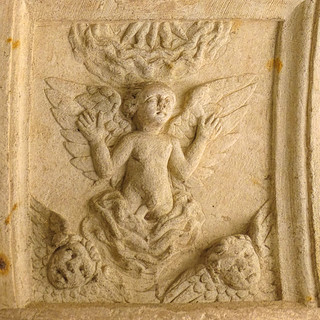
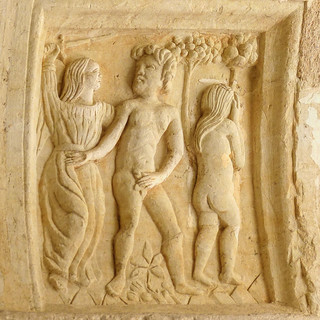
A winged figure rises from swirling cloud-forms, flanked by two smaller cherubic heads. Likely intended as a symbolic heavenly presence anchoring the theological register of the vault.
Adam and Eve, nude, are driven from Eden by an angel raising a sword. Eve turns away in shame while Adam shields himself. Simple ground-lines and foliage mark the loss of paradise.
Massacre of the Innocents, and Annunciation
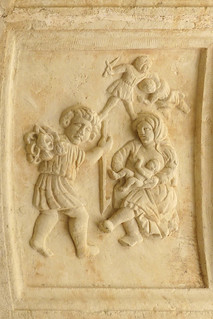
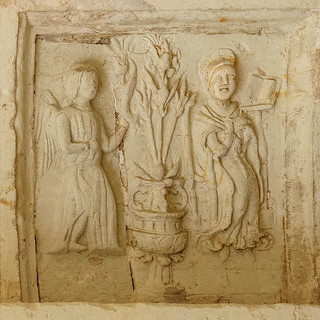
A mother attempts to shield her child while a soldier raises his blade; another child is being seized above. Figures are compact and energetic, carved in shallow but expressive relief.
The angel Gabriel approaches the Virgin across a lily-filled vase. Mary raises her hand in acceptance while holding an open book. A quiet, devotional rendering consistent with monastic settings.
Epiphany, and Pieta
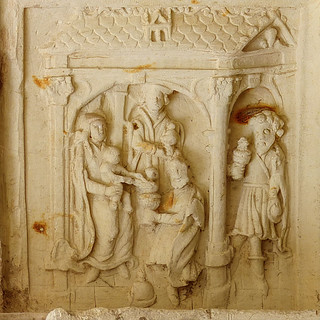
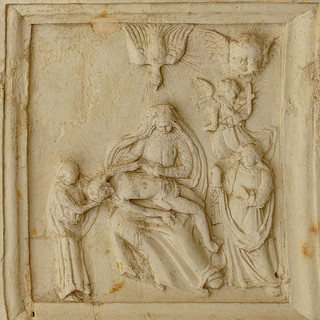
Under a tiled roof supported by columns, the Virgin presents the Christ Child to a kneeling Magus while the others stand behind. One attendant approaches from the right with a vessel.
The Virgin cradles the dead Christ while angels hover above. A small attendant figure assists in supporting the body. A sombre devotional subject appropriate to the sacristy context.
Education of the Virgin, and Donor

A youthful Mary is guided at a reading-desk by an older female figure, likely St Anne. The scene is rare but well-attested in female monastic iconography.
A seated noblewoman presents a stylised architectural model, a roofed building with window apertures, in a gesture of offering. The motif identifies her as a female founder or benefactress, probably linked to Fontevraud’s patronal network. Her secular dress and composed posture rule out identification as a saint or allegory.
St Nicholas and the Gold for the Dowries
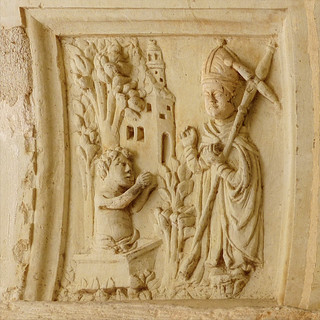
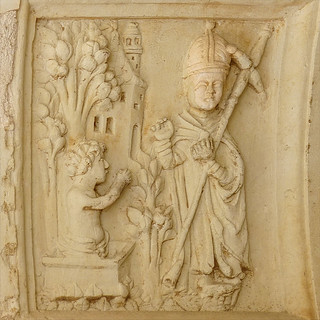
Nicholas, depicted as a bishop, approaches a window where a man sits. The saint’s gesture of offering recalls the miracle of the three dowries given in secret.
A nearly identical scene showing the saint once again approaching a seated figure at a window. Likely completing the narrative arc of multiple dowry gifts.
St Nicholas and the Three Boys
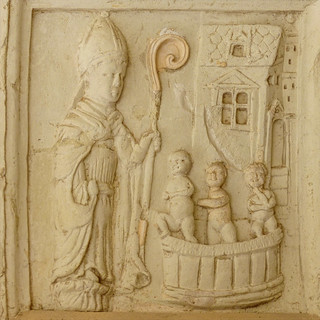
Nicholas stands beside the vessel containing the three resurrected boys. Though simplified, the traditional iconography, the children emerging from a tub, is unmistakable.
Interpretation
The cycle integrates Mariological, Christological, and Nicholas-themed imagery, all appropriate to Fontevraud’s status as a double monastery under female governance. The donor panel underscores the abbey’s tradition of noble female patronage and may reflect ongoing building works around 1500–1520, when Fontevraud underwent significant refurbishment.
The stylistic consistency across the reliefs suggests execution by a single atelier active in the Loire-Anjou region, probably connected with the circle of local sculptors working on late Gothic domestic and monastic interiors.
